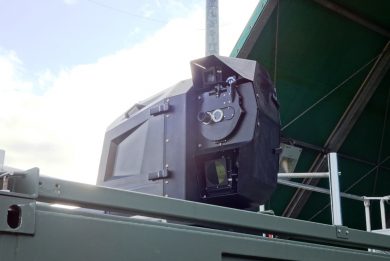IDEF 2023 – Meteksan launches its Felix on-the-move C-UAS system
Leveraging its know-how in radiofrequency sensors and effectors at IDEF 2023 Meteksan launched the Felix, an on-the-move C-UAS system that might be a solution for example for convoy protection
The increasing lethality of UAVs and loitering munitions is bringing numerous companies to develop countermeasures against those assets. These first need sensors capable to detect the threat, which is then identified and dealt with soft and/or hard kill effectors.
Meteksan of Turkey proposes a solution that can be fitted to a 4×4 light armoured vehicle, providing both detection and neutralisation capabilities, all using the radiofrequency spectrum
Detection is carried out using the company Retinar AESA S-band radar, already adopted on other GBAD systems such as the Burç unveiled by Roketsan also at IDEF 2023.
Each AESA antenna of the new Retinar AESA covers 90°x90°, full 360° hemispheric coverage needing therefore four antennas. The radar is based on the Multiple-Input Multiple-Output structure, and each antenna weighs less than 35 kg and has power consumption under 600 W. The upgrade rate is 1 Hz, thus each second the air picture is updated, allowing detection and tracking of fast flying targets, the radar being also capable to find slow moving targets, down to a 0.2 m/s speed (0.72 km/h). Maximum instrumented range is 24 km, against 20 m2 radar cross section (RCS) targets; however for the application on the Felix what is important is the Retinar AESA capacity to detect and track small targets such as Class 1 UAVs, and to this end the Retinar AESA can detect a 0.01 m2 RCS target at 4 km and a 1 m2 RCS target, representative of a tactical UAS, at 10 km. Each antenna has three elements, one big element at one side, the transmitter, one bigger element in the middle, the isolator, and a smaller element which is the receiver.
As detector/effector the Felix is fitted with the Meteksan Electronic Attack System. Not many data were provided on this system, which is omnidirectional and covers the entire VHF/UHF spectrum. While the radar antennas are located on the four upper sides of the vehicle, jamming antennas are installed on a superstructure at the rear. It is based on a channelised broadband receiving structure allowing simultaneous target detection in the entire band allowing adaptive jamming of different targets on different frequencies, EDR On-Line understood, which permits to neutralise them while preserving as much as possible friendly communications capacity.
Shown as a model, the Felix is vehicle agnostic and can be fitted on any platform that provides enough electric power to activate the radars and the jamming system.
Photos P. Valpolini






